Last Friday, a major exhibition of the works of Amedeo Modigliani at the Doge’s Palace in Genoa announced that it would be closing early, after authorities confirmed that most of the paintings in the exhibit–21 out of 30, to be precise–were fakes.
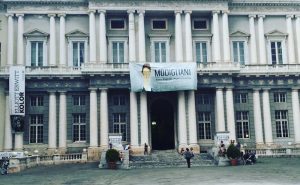
As reported by the British newspaper The Telegraph, Carlo Pepi, a 79-year-old art critic, raised the alarm after seeing advertisements for the exhibit featuring a 1918 portrait titled “Marie, Daughter of the People.”
“My goodness, when I saw the poster of Marie and then looked through the catalogue and saw the others, I thought, poor Modigliani, to attribute to him these ugly abominations,” Pepi told The Telegraph.
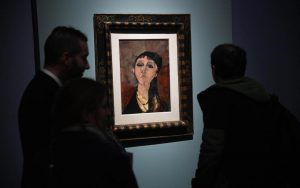
I am fascinated bytale art crimes. I know that’s a weird thing to admit, but I do. Maybe it’s the bizarre combination of ruthlessness and beauty that go into so many of these crimes. Maybe it’s the dirty history behind images that we tend to take for granted–for example, Edvard Munch’s The Scream has been stolen twice, in outlandish circumstances…and recovered in operations just as over-the-top. To be honest, I’m thoroughly enamored with the idea that you could get a job hunting these forgeries down, too. Tales of the FBI’s Art Thefts department
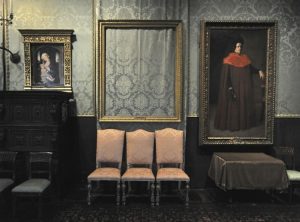 It seems like the stuff of fiction–and yet the repercussions of art crime are international and unforgettable. If you’ve ever been to the Isabella Stuart Gardener Museum, and looked at the empty frames that still hang on the wall in memory of the (still missing) paintings that were cut out of them, you know what a palpable loss those pieces still have (see image to left, via the New York Post). For those who have lost, or found, pieces stolen by Nazi authorities or during the Stalinist purgers, the enormity of the crime committed cannot be contained in a frame. Art speaks to us in a way that words and deeds cannot, and to rob someone of that is to rob them of their humanity. It also robs humanity of some truly staggering works of genius as well–the number of pieces that now have dubious provenance (the official history of a painting that traces its whereabouts throughout its life) is enormous, and is ever-growing.
It seems like the stuff of fiction–and yet the repercussions of art crime are international and unforgettable. If you’ve ever been to the Isabella Stuart Gardener Museum, and looked at the empty frames that still hang on the wall in memory of the (still missing) paintings that were cut out of them, you know what a palpable loss those pieces still have (see image to left, via the New York Post). For those who have lost, or found, pieces stolen by Nazi authorities or during the Stalinist purgers, the enormity of the crime committed cannot be contained in a frame. Art speaks to us in a way that words and deeds cannot, and to rob someone of that is to rob them of their humanity. It also robs humanity of some truly staggering works of genius as well–the number of pieces that now have dubious provenance (the official history of a painting that traces its whereabouts throughout its life) is enormous, and is ever-growing.
However, if you’re even in Vienna, check out the Fälschermuseum to learn how much fun fakeries can be. This museum is dedicated to the history of fake art, forgeries, and art fraud, and, though small, provides a fascinating education on the hows and whys of fakes, as well as some of the incredible stories behind some of the world’s best fakes, and most oddly satisfying stories–like Tom Keating, who wrote notes on his canvas before painting over them so that when the painting was x-rayed, his forgery would be discovered.
Even better, if you don’t feel like leaving your armchair/couch/beach chair/office, then check out these fantastic books on art forgeries, fakeries, and the wild stories behind them in these books!
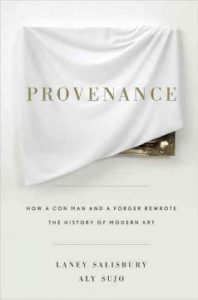 Provenance: Speaking of Modigliani forgeries….John Myatt is perhaps one of the 20th century’s most famous (and most prolific) art forgers, and his talents for visual mimicry are shocking (check out his website here!). In 1986, trying desperately to stay financially afloat, Myatt advertised his talents in the hopes of painting a few copies for money. Instead, he was contacted by con artist John Drewe, who embroiled Myatt in one of the biggest, most wide-ranging art frauds in history. In the end, a Modigliani forgery played an enormous part in bringing Drewe’s scheme down, and though Myatt spent time in prison for his role in the con, his paintings are now some of the most highly-sought in Britain. Laney Salisbury tells his and Drewe’s story with insight, wit, and a perfect sense of timing. Though we as readers never lose sight of the gravity of the crimes being committed, the book still reads a lot like a crime caper, and provides an enormously entertaining education on the art world.
Provenance: Speaking of Modigliani forgeries….John Myatt is perhaps one of the 20th century’s most famous (and most prolific) art forgers, and his talents for visual mimicry are shocking (check out his website here!). In 1986, trying desperately to stay financially afloat, Myatt advertised his talents in the hopes of painting a few copies for money. Instead, he was contacted by con artist John Drewe, who embroiled Myatt in one of the biggest, most wide-ranging art frauds in history. In the end, a Modigliani forgery played an enormous part in bringing Drewe’s scheme down, and though Myatt spent time in prison for his role in the con, his paintings are now some of the most highly-sought in Britain. Laney Salisbury tells his and Drewe’s story with insight, wit, and a perfect sense of timing. Though we as readers never lose sight of the gravity of the crimes being committed, the book still reads a lot like a crime caper, and provides an enormously entertaining education on the art world.
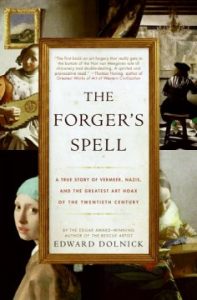 The Forger’s Spell: In 1945, Han Van Meegeren, a Dutch artist, was arrested and charged with collaborating with the enemy, for having allegedly sold a Vermeer painting to Nazi officer Hermann Goering. Van Meegeren’s defense was a shocking one–the painting, he claimed, was not a Vermeer. It was a Van Meegeren. Moreover, he had traded the false Vermeer for 200 original Dutch paintings seized by Goering in the beginning of the war. Van Meegeren was actually called upon to paint another forgery before the court before his story was believed, and Van Meegeren’s charge was reduced to forgery, for which he spent about a year in confinement. In this engaging work, Edward Dolnick not only relates the story of the forgeries, but placed Van Meegeren’s work in the context of the Second World War, emphasizing what a dangerous game he was playing–and the real effects his actions had on the art world. It’s an enlightening and tense story that will appeal to military historians as well as art lovers. You can see Van Meegeren’s forgeries for yourself here . If you like Dolnick’s writing, be sure to check out The Rescue Artist, about the theft and recovery of Munch’s The Scream, too!
The Forger’s Spell: In 1945, Han Van Meegeren, a Dutch artist, was arrested and charged with collaborating with the enemy, for having allegedly sold a Vermeer painting to Nazi officer Hermann Goering. Van Meegeren’s defense was a shocking one–the painting, he claimed, was not a Vermeer. It was a Van Meegeren. Moreover, he had traded the false Vermeer for 200 original Dutch paintings seized by Goering in the beginning of the war. Van Meegeren was actually called upon to paint another forgery before the court before his story was believed, and Van Meegeren’s charge was reduced to forgery, for which he spent about a year in confinement. In this engaging work, Edward Dolnick not only relates the story of the forgeries, but placed Van Meegeren’s work in the context of the Second World War, emphasizing what a dangerous game he was playing–and the real effects his actions had on the art world. It’s an enlightening and tense story that will appeal to military historians as well as art lovers. You can see Van Meegeren’s forgeries for yourself here . If you like Dolnick’s writing, be sure to check out The Rescue Artist, about the theft and recovery of Munch’s The Scream, too!
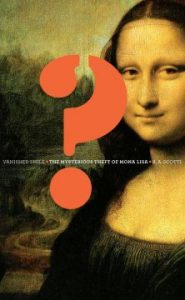 Vanished Smile: The Mysterious Theft of the Mona Lisa: On August 21, 1911, Leonardo da Vinci’s most celebrated painting vanished from the Louvre. The prime suspects were as shocking as the crime: Pablo Picasso and Guillaume Apollinaire, young provocateurs of a new art. The sensational disappearing act captured the world’s imagination. Crowds stood in line to view the empty space on the museum wall. Thousands more waited, as concerned as if Mona Lisa were a missing person, for news of the lost painting. Though she was recovered in Florence in 1913, R.A. Scotti emphasizes that still in the case still linger: Who really lifted Mona Lisa…and why? This story is part mystery, part history (the case was one of the first to use modern forensic science and profiling), and part love story to Paris, the Louvre, and the art it holds, this is a really engaging look into the history of what has become the most famous painting in western culture.
Vanished Smile: The Mysterious Theft of the Mona Lisa: On August 21, 1911, Leonardo da Vinci’s most celebrated painting vanished from the Louvre. The prime suspects were as shocking as the crime: Pablo Picasso and Guillaume Apollinaire, young provocateurs of a new art. The sensational disappearing act captured the world’s imagination. Crowds stood in line to view the empty space on the museum wall. Thousands more waited, as concerned as if Mona Lisa were a missing person, for news of the lost painting. Though she was recovered in Florence in 1913, R.A. Scotti emphasizes that still in the case still linger: Who really lifted Mona Lisa…and why? This story is part mystery, part history (the case was one of the first to use modern forensic science and profiling), and part love story to Paris, the Louvre, and the art it holds, this is a really engaging look into the history of what has become the most famous painting in western culture.
